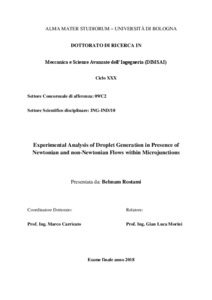Rostami, Behnam
(2018)
Experimental Analysis of Droplet Generation in Presence of
Newtonian and non-Newtonian Flows within Microjunctions, [Dissertation thesis], Alma Mater Studiorum Università di Bologna.
Dottorato di ricerca in
Meccanica e scienze avanzate dell'ingegneria, 30 Ciclo. DOI 10.6092/unibo/amsdottorato/8600.
Documenti full-text disponibili:
![[img]](http://amsdottorato.unibo.it/8600/1.hassmallThumbnailVersion/Thesis_final_Behnam%20Rostami.pdf)  Anteprima |
|
Documento PDF (English)
- Richiede un lettore di PDF come Xpdf o Adobe Acrobat Reader
Disponibile con Licenza: Salvo eventuali più ampie autorizzazioni dell'autore, la tesi può essere liberamente consultata e può essere effettuato il salvataggio e la stampa di una copia per fini strettamente personali di studio, di ricerca e di insegnamento, con espresso divieto di qualunque utilizzo direttamente o indirettamente commerciale. Ogni altro diritto sul materiale è riservato.
Download (10MB)
| Anteprima
|
Abstract
Microdroplets have attracted increasing interest among researchers due to the wide spread of promising technological applications such as biological analysis, cancer diagnosis, drug discovery and chemical reactions. With respect to traditional emulsion methods which are usually able to produce droplets with a broad size variation (polydispersed emulsions), microfluidic devices have been developed to produce monodispersed microdroplets with a controllable size. The diameter and size variation of droplets are controlled by a series of parameters, including the geometries and dimensions of the microfluidic devices, properties of the liquids, flow rates and surfactant concentrations.
In this Ph.D. thesis, droplet formation has been analyzed experimentally, thanks to a series of specific tests on simple microfluidic devices devoted to droplet generation based on the use of T-junctions or micro cross-junctions. The experimental work has been focused on the analysis of the control of droplet regime which can be activated in a microfluidic droplet generator in presence of Newtonian and non-Newtonian dispersed phases, with or without the addition of surfactants. The mechanism of the droplet formation has been studied by following the evolution of the interface between the immiscible liquids at the microjunction thanks to the post processing of images acquired by using a speed camera connected to an inverted microscope. In order to study the behavior of non-Newtonian shear thinning liquids during droplet formation, Xanthan gum aqueous solutions have been used because their rheological properties are very similar to those of blood. The effect on the droplet regimes of the main controlling parameters, such as the flow rates of the immiscible liquids introduced in the microfluidic device, fluid viscosity and interfacial tension has been studied with the aim to individuate the range of these controlling parameters for which the microfluidic device is able to produce monodispersed droplets with an assigned volume and frequency.
Abstract
Microdroplets have attracted increasing interest among researchers due to the wide spread of promising technological applications such as biological analysis, cancer diagnosis, drug discovery and chemical reactions. With respect to traditional emulsion methods which are usually able to produce droplets with a broad size variation (polydispersed emulsions), microfluidic devices have been developed to produce monodispersed microdroplets with a controllable size. The diameter and size variation of droplets are controlled by a series of parameters, including the geometries and dimensions of the microfluidic devices, properties of the liquids, flow rates and surfactant concentrations.
In this Ph.D. thesis, droplet formation has been analyzed experimentally, thanks to a series of specific tests on simple microfluidic devices devoted to droplet generation based on the use of T-junctions or micro cross-junctions. The experimental work has been focused on the analysis of the control of droplet regime which can be activated in a microfluidic droplet generator in presence of Newtonian and non-Newtonian dispersed phases, with or without the addition of surfactants. The mechanism of the droplet formation has been studied by following the evolution of the interface between the immiscible liquids at the microjunction thanks to the post processing of images acquired by using a speed camera connected to an inverted microscope. In order to study the behavior of non-Newtonian shear thinning liquids during droplet formation, Xanthan gum aqueous solutions have been used because their rheological properties are very similar to those of blood. The effect on the droplet regimes of the main controlling parameters, such as the flow rates of the immiscible liquids introduced in the microfluidic device, fluid viscosity and interfacial tension has been studied with the aim to individuate the range of these controlling parameters for which the microfluidic device is able to produce monodispersed droplets with an assigned volume and frequency.
Tipologia del documento
Tesi di dottorato
Autore
Rostami, Behnam
Supervisore
Dottorato di ricerca
Ciclo
30
Coordinatore
Settore disciplinare
Settore concorsuale
Parole chiave
microdroplets; Newtonian and non-Newtonian solutions; microjunctions; Experimental microfluidics
URN:NBN
DOI
10.6092/unibo/amsdottorato/8600
Data di discussione
4 Maggio 2018
URI
Altri metadati
Tipologia del documento
Tesi di dottorato
Autore
Rostami, Behnam
Supervisore
Dottorato di ricerca
Ciclo
30
Coordinatore
Settore disciplinare
Settore concorsuale
Parole chiave
microdroplets; Newtonian and non-Newtonian solutions; microjunctions; Experimental microfluidics
URN:NBN
DOI
10.6092/unibo/amsdottorato/8600
Data di discussione
4 Maggio 2018
URI
Statistica sui download
Gestione del documento:


 Login
Login
